GIGABYTE AM1M-S2H Review: What Can $35 Get You?
by Ian Cutress on August 15, 2014 3:00 PM EST- Posted in
- Motherboards
- AMD
- Gigabyte
- Kabini
- AM1
Gaming Benchmarks
While no regular user of the AM1 platform would pair up the system with a $500 GPU, all our results are based on the more mainstream to high end and it is interesting to see if the lack of speed in the lower powered CPU systems makes a significant difference in frame rates.
Also being tested here, aside from the CPU performance effect, is the use of four PCIe lanes from the APU rather than eight or sixteen from the high end platforms. These are also PCIe 2.0 lanes rather than PCIe 3.0, limiting the bandwidth even further.
F1 2013
First up is F1 2013 by Codemasters. I am a big Formula 1 fan in my spare time, and nothing makes me happier than carving up the field in a Caterham, waving to the Red Bulls as I drive by (because I play on easy and take shortcuts). F1 2013 uses the EGO Engine, and like other Codemasters games ends up being very playable on old hardware quite easily. In order to beef up the benchmark a bit, we devised the following scenario for the benchmark mode: one lap of Spa-Francorchamps in the heavy wet, the benchmark follows Jenson Button in the McLaren who starts on the grid in 22nd place, with the field made up of 11 Williams cars, 5 Marussia and 5 Caterham in that order. This puts emphasis on the CPU to handle the AI in the wet, and allows for a good amount of overtaking during the automated benchmark. We test at 1920x1080 on Ultra graphical settings.
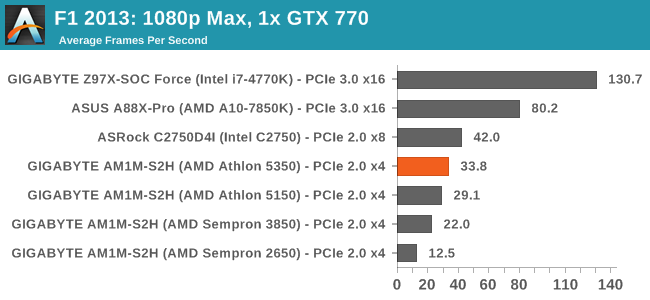
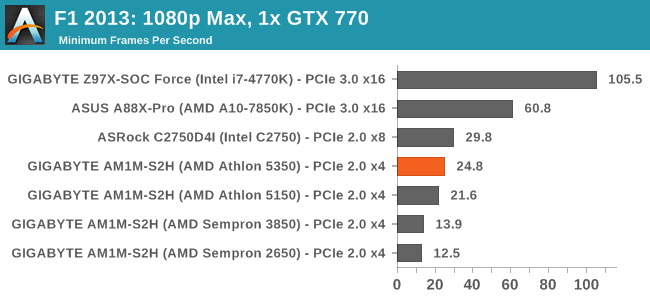
Bioshock Infinite
Bioshock Infinite was Zero Punctuation’s Game of the Year for 2013, uses the Unreal Engine 3, and is designed to scale with both cores and graphical prowess. We test the benchmark using the Adrenaline benchmark tool and the Xtreme (1920x1080, Maximum) performance setting, noting down the average frame rates and the minimum frame rates.
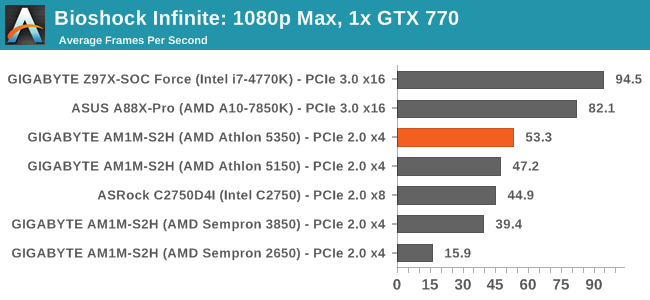
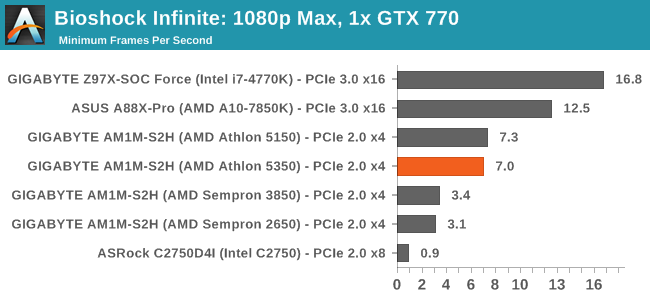
Tomb Raider
The next benchmark in our test is Tomb Raider. Tomb Raider is an AMD optimized game, lauded for its use of TressFX creating dynamic hair to increase the immersion in game. Tomb Raider uses a modified version of the Crystal Engine, and enjoys raw horsepower. We test the benchmark using the Adrenaline benchmark tool and the Xtreme (1920x1080, Maximum) performance setting, noting down the average frame rates and the minimum frame rates.
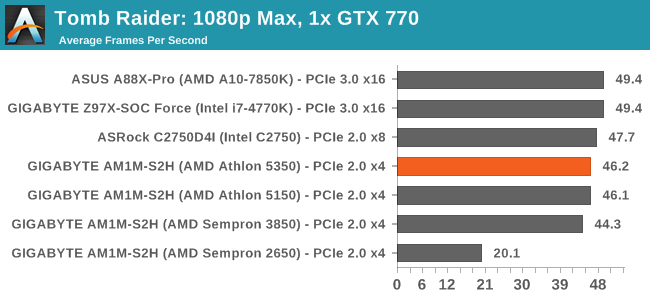
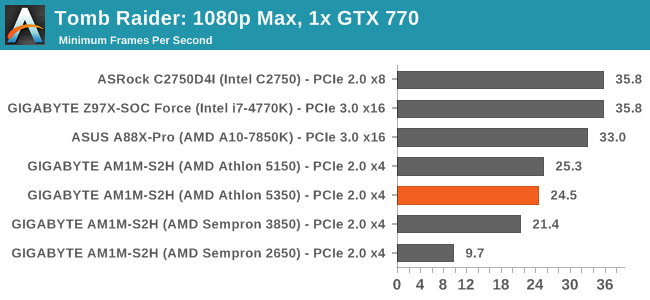
Sleeping Dogs
Sleeping Dogs is a benchmarking wet dream – a highly complex benchmark that can bring the toughest setup and high resolutions down into single figures. Having an extreme SSAO setting can do that, but at the right settings Sleeping Dogs is highly playable and enjoyable. We run the basic benchmark program laid out in the Adrenaline benchmark tool, and the Xtreme (1920x1080, Maximum) performance setting, noting down the average frame rates and the minimum frame rates.


Company of Heroes 2
Company of Heroes 2 also can bring a top end GPU to its knees, even at very basic benchmark settings. To get an average 30 FPS using a normal GPU is a challenge, let alone a minimum frame rate of 30 FPS. For this benchmark I use modified versions of Ryan’s batch files at 1920x1080 on High. COH2 is a little odd in that it does not scale with more GPUs with the drivers we use.
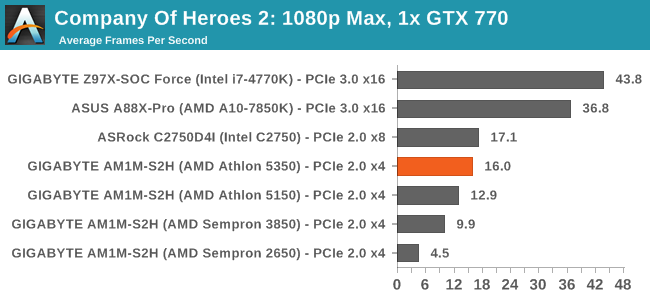
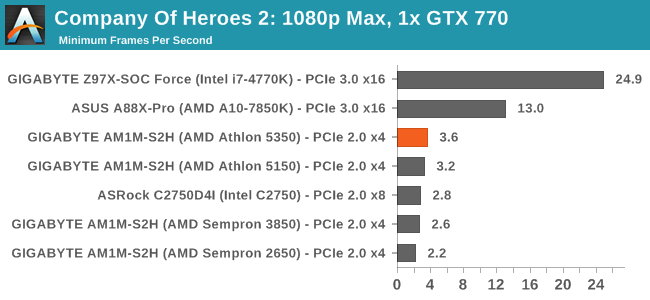
Battlefield 4
The EA/DICE series that has taken countless hours of my life away is back for another iteration, using the Frostbite 3 engine. AMD is also piling its resources into BF4 with the new Mantle API for developers, designed to cut the time required for the CPU to dispatch commands to the graphical sub-system. For our test we use the in-game benchmarking tools and record the frame time for the first ~70 seconds of the Tashgar single player mission, which is an on-rails generation of and rendering of objects and textures. We test at 1920x1080 at Ultra settings.
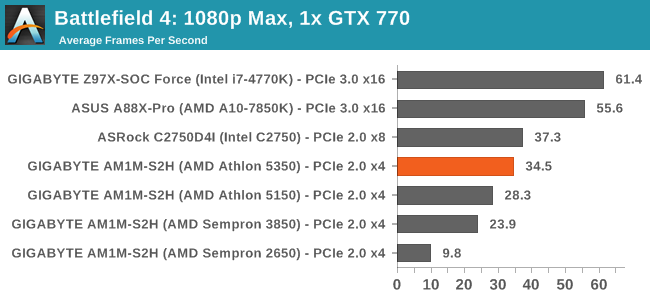







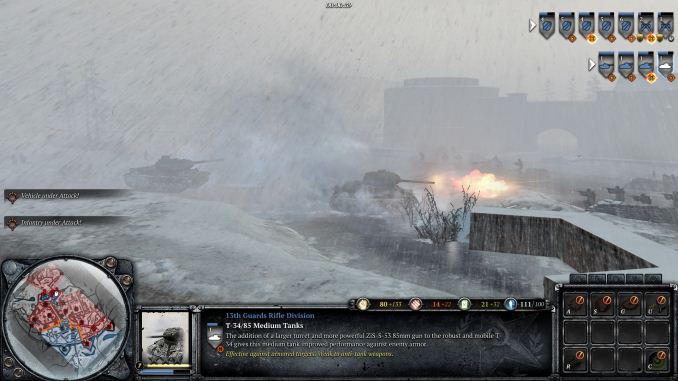









45 Comments
View All Comments
Flunk - Friday, August 15, 2014 - link
I'm confused as to why this needs an ATX 4-pin connector at all, they were introduced to provide more power to power-hungry CPUs. This doesn't need much power on the CPU socket so it seems unnecessary.It would also have been nice to see the gaming results with the IGP, most of these boards are going to be utilized with the IGP.
Considering the price of this platform the performance seems really great, I think I would recommend something like this to people who just want a very basic desktop system.
TerdFerguson - Friday, August 15, 2014 - link
This looks great, although I insist that the possibility of a $35 functional motherboard is far less astonishing than the possibility of a $200+ motherboard. Yet again, I challenge any honest, authoritative source to break down the build cost of a "high end" motherboard.StrangerGuy - Friday, August 15, 2014 - link
Every industry tries to rip people off as much as they could get away with it...Why would mobos be any different? Most people don't need more than a $50 even for gaming purposes, let alone $100+.Lonyo - Saturday, August 16, 2014 - link
The cost of a product is more than just the bill of materials.kmmatney - Friday, August 15, 2014 - link
Maybe it cheaper to give the cpu it's own power, than routing it from the main connector? I'm sure every decision on this motherboard had cost in mind.DanNeely - Friday, August 15, 2014 - link
Probably to feed the GPU slot if someone puts a card with a decent power draw. The 24pin connector dates back to when 3.3/5V were used to power most of the mobo and only has 2 12V wires.MikeMurphy - Sunday, August 17, 2014 - link
Because when you plug in a 75w PCIe card you need all the power you can get.You make good points on the 770 but I think the point was to show which apps are CPU limited. The 5350 IGP is already well documented.
wrkingclass_hero - Friday, August 15, 2014 - link
0.0 dat power supply...Daniel Egger - Friday, August 15, 2014 - link
The selection of comparison points is rather strange, why compare power consumption of completely different aimed Intel systems (Servers, Top End of Halswells and an Atom?) rather than a Haswell Celeron or low end i3 while the benchmarks have a completely different and partially also much larger set of systems.ozzuneoj86 - Friday, August 15, 2014 - link
It seems like this happens a lot, and there are usually reasons for it, such as a lack of hardware to test on or time constraints, but if the results don't really tell us anything in the end, it is a bit frustrating. I think I said this the last time we had a Kabini review. Basically, the results often only show us that the CPU is slower than far more expensive systems, and that the AM1 CPUs increase slightly in performance as the price goes up... exactly as you'd expect. We get very little in the way of comparison between competing products, or even between old and new products. I really hope Anandtech will start supplying the reviewers with some more low end platforms if we're going to keep getting reviews like this. I just feel kind of bad for the writers of these nice reviews when the readers walk away from a review in the end not really having any more information about how the product compares to similarly priced options, slightly more expensive options, or older options that they might be able to get cheaper. They can only run tests with hardware that is available to them... and clearly there's a lack of entry-level hardware available to the guys here. I'm sure someone would be willing to donate some stuff to make these reviews more helpful. We need some comparisons with ivy and sandy bridge celeron (847, 1037u), older APUs (E350, A4 3xxx), Haswell celeron (G1830), older Athlons (X2, II X2, X2 e low power chips), Core 2 (E4300, E8400) and 771 Xeons (like the L5240, L5420, since they can be had for cheap now and modded to 775). These are the options I think of when I think of systems like Kabini, and they are for the most part nowhere to be seen in these reviews.